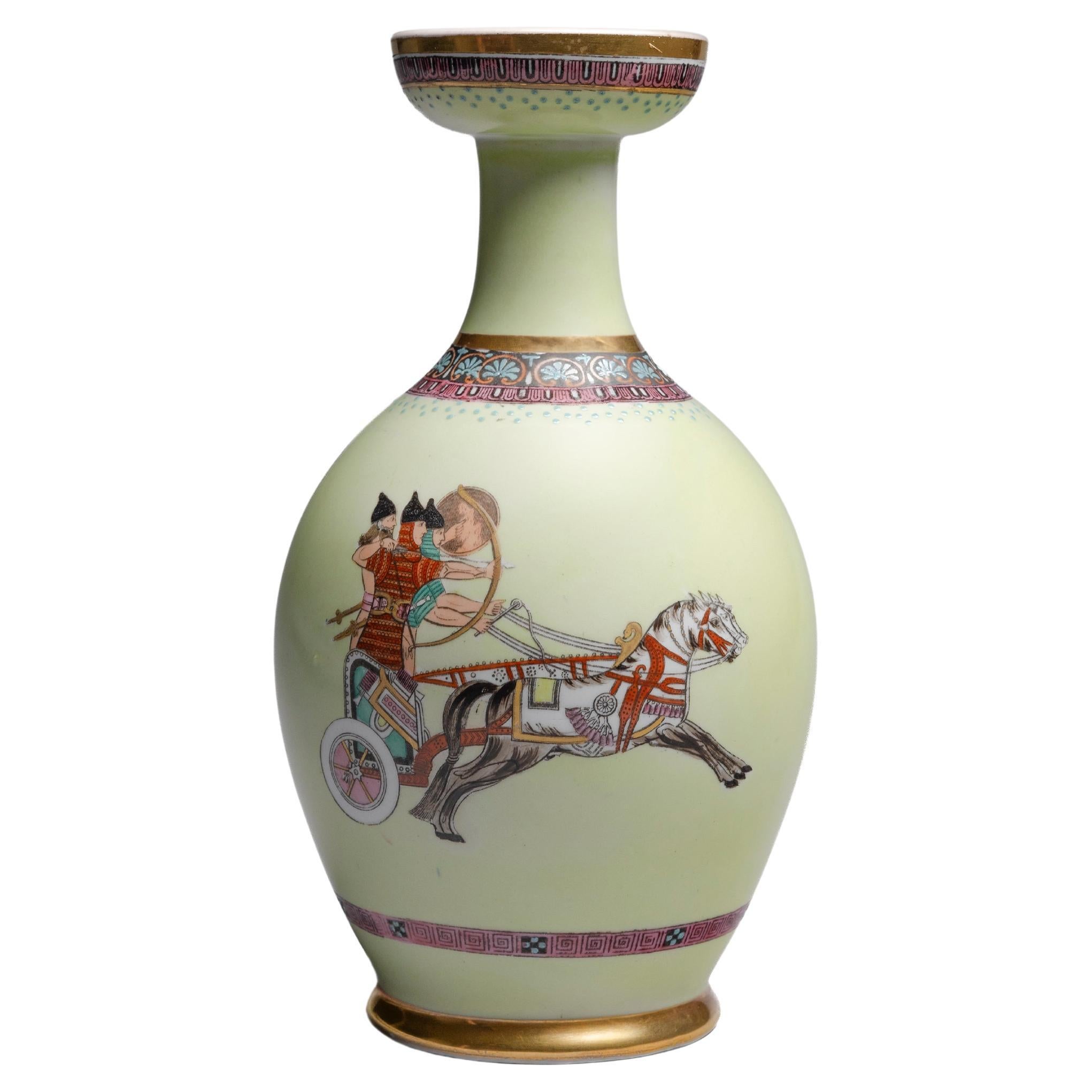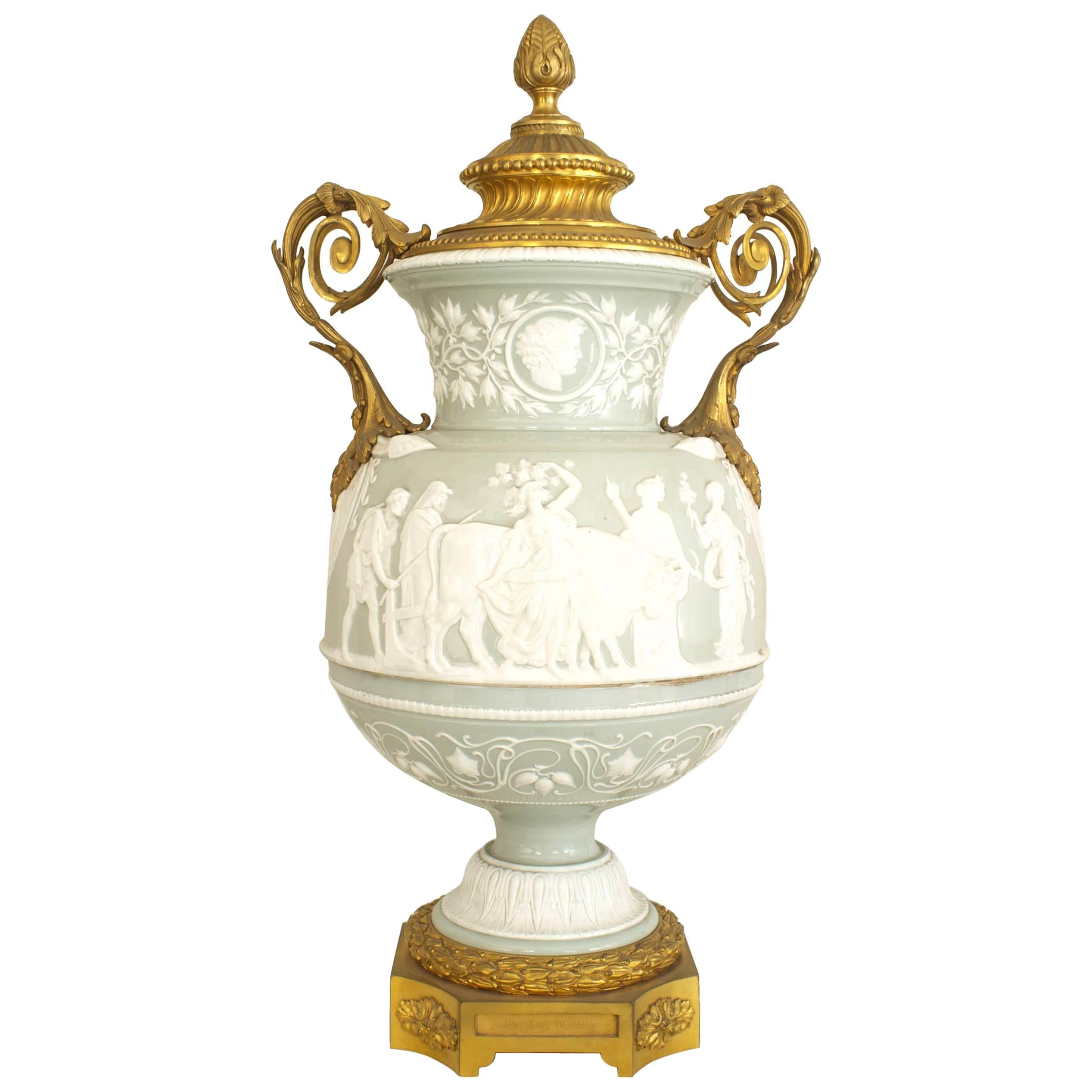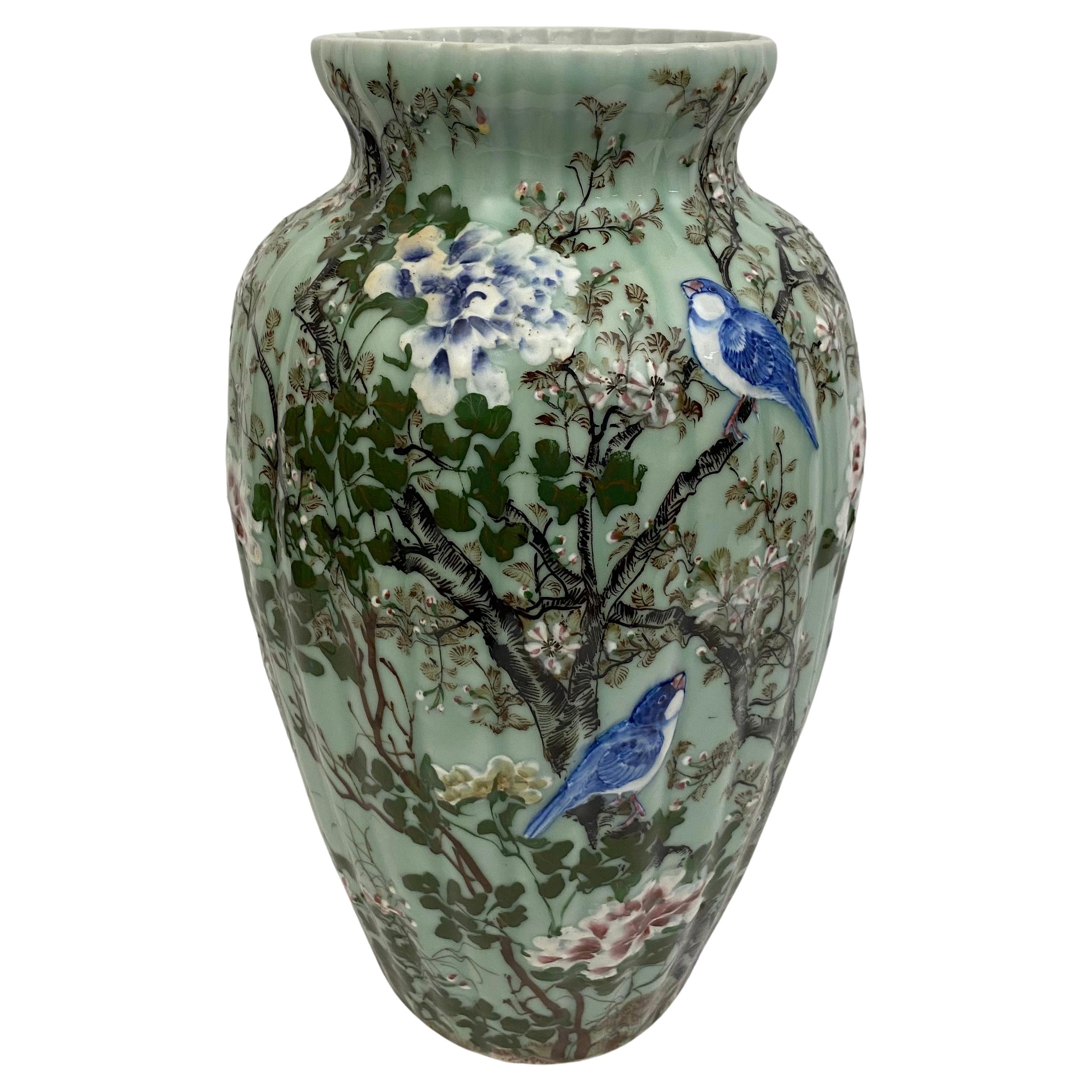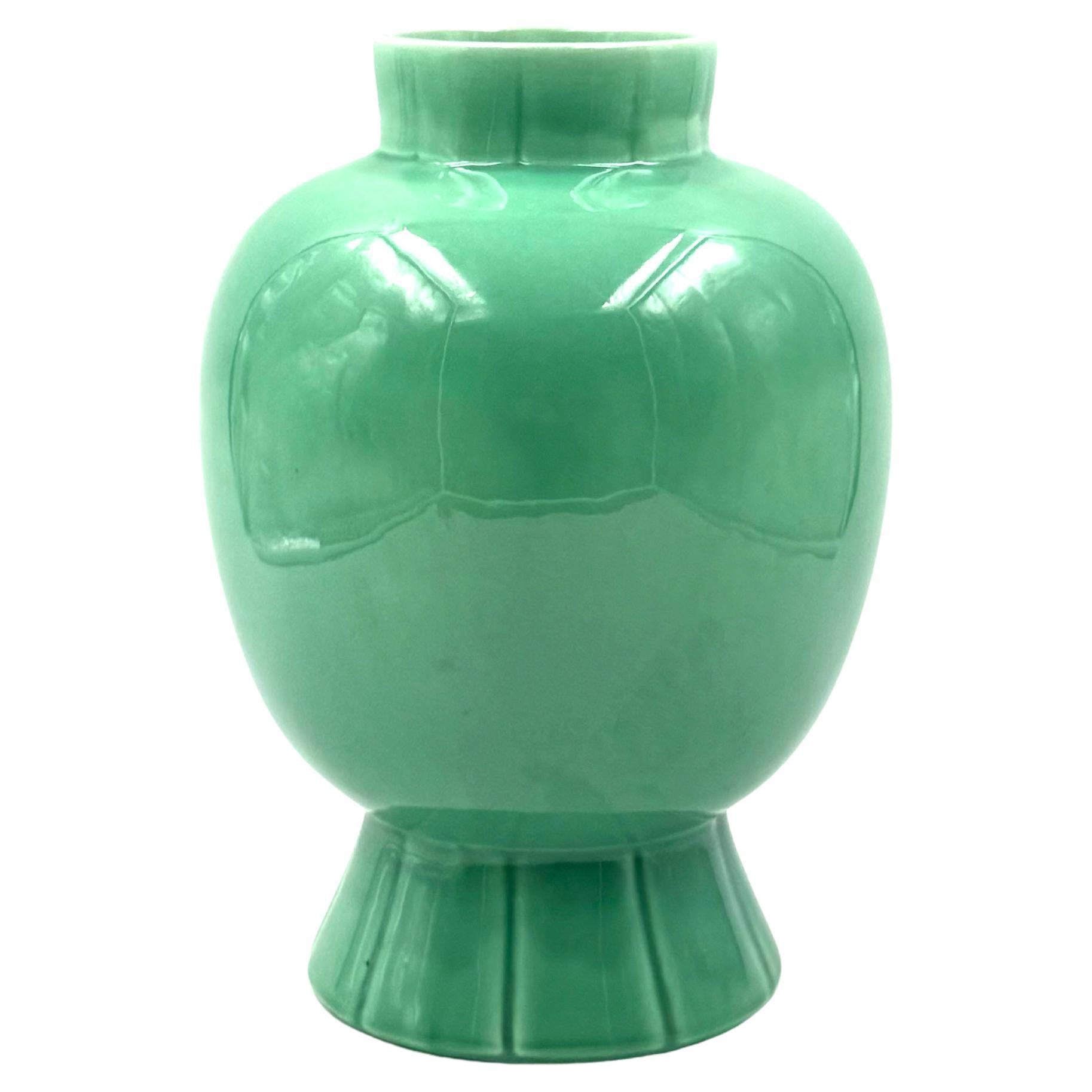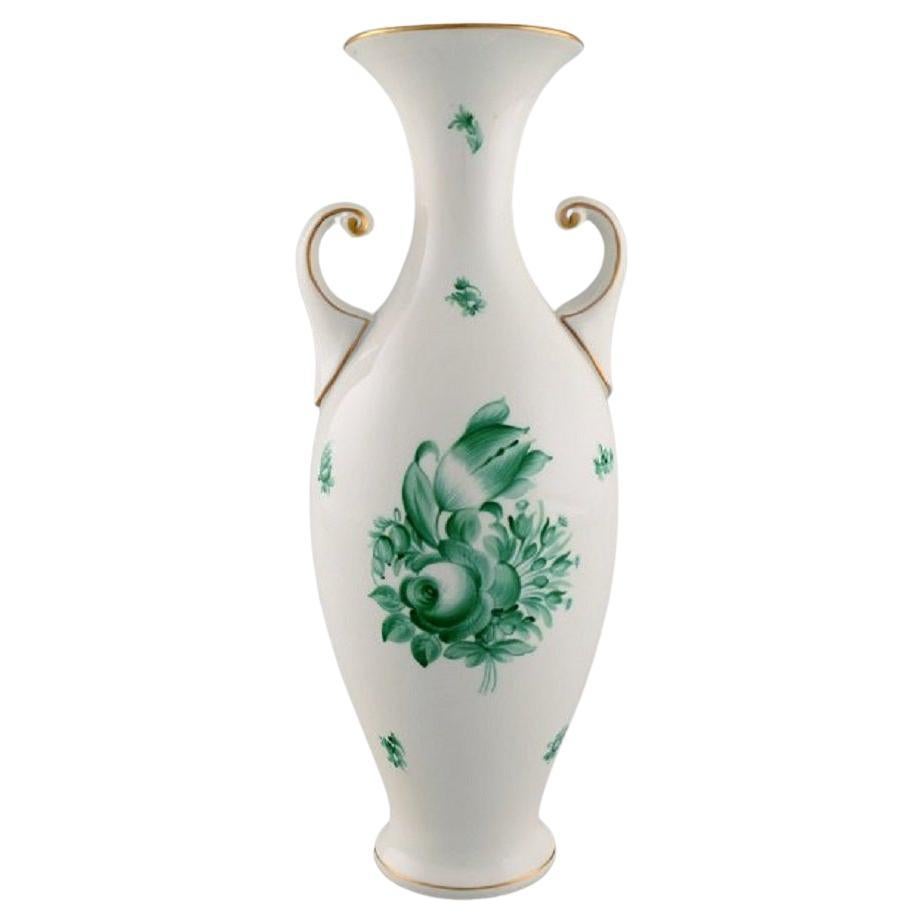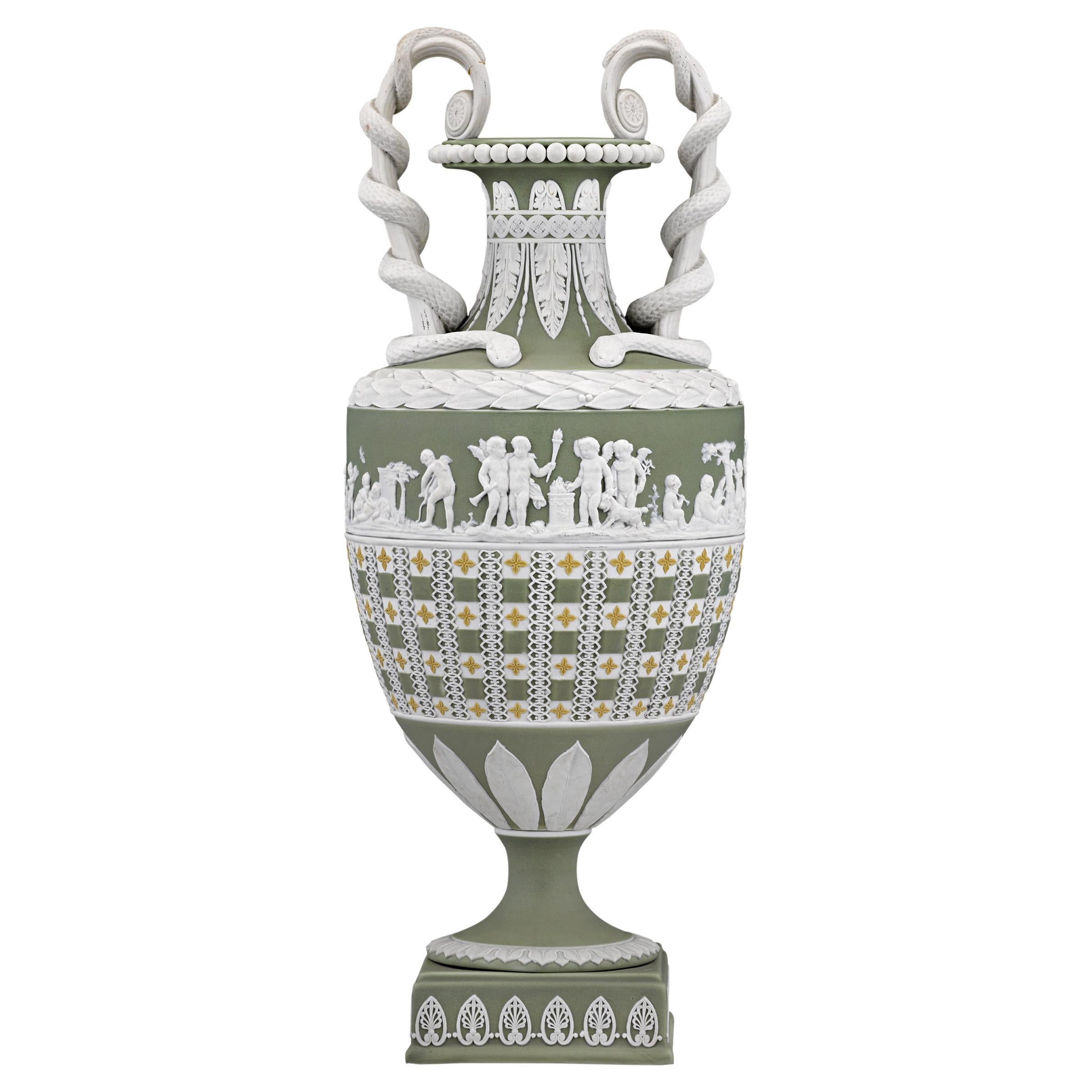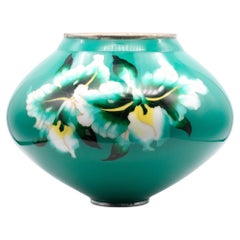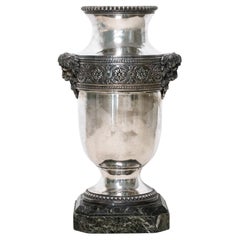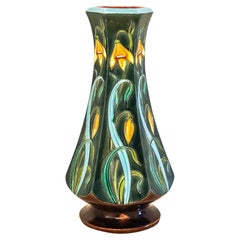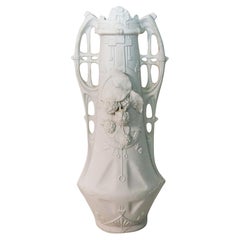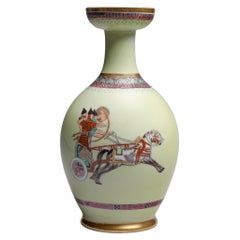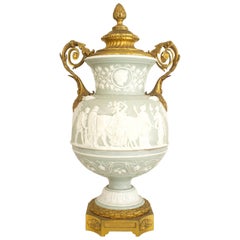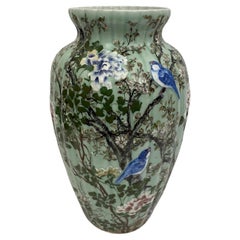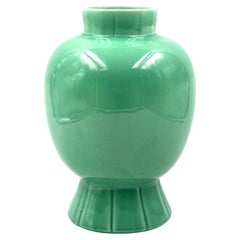Items Similar to VILLEROY & BOCH METTLACH 1890 Phanolith Neo Classic Green Cameo Amphora
Want more images or videos?
Request additional images or videos from the seller
1 of 12
VILLEROY & BOCH METTLACH 1890 Phanolith Neo Classic Green Cameo Amphora
$2,998.50
$3,99825% Off
£2,295.83
£3,061.1025% Off
€2,630.29
€3,507.0625% Off
CA$4,278.74
CA$5,704.9925% Off
A$4,683.01
A$6,244.0125% Off
CHF 2,434.25
CHF 3,245.6725% Off
MX$56,361.64
MX$75,148.8525% Off
NOK 30,602.39
NOK 40,803.1825% Off
SEK 28,705.99
SEK 38,274.6625% Off
DKK 19,646.59
DKK 26,195.4525% Off
About the Item
A neo classic green cameo amphora designed by Villeroy & Boch in Mettlach.
This is a very rare tall Phanolith cameo vase, created in Germany by the Villeroy & Boch Mettlach company, back in the 1890's. The massive tall vase has been crafted with neo classic patterns of a two-handles amphora in green Phanolith and stoneware with translucent white cameo, showing two different mythological scenes of the three graces. Mettlach Phanolith items were translucent and made of soft-paste porcelain in the technique developed at Mettlach by Jean Baptiste Stahl. This technique is similar to that of the earlier Wedgwood wares from England. The American Museum of Ceramic Art has in their permanent collection a very similar one to this.
Jean-Baptiste Stahl
He was the inventor and designer of the Phanolith. He grew up in the traditional pottery of his family. His studies of ceramics, modelling and sculpture led him to Strasbourg and Höhr-Grenzhausen. His detailed, translucent and finely worked porcelain reliefs gained him a gold medal at the 1900 Paris World's Fair. Partly influenced by Art Nouveau, Jean-Baptiste Stahl took topics from Greek mythology and rural life. Usually, the white translucent figures are finely set on a blue or green background that partly shines through. Striking is his absolute eye for the detailed modelling of his figures in a very delicate and lively way. In order to increase the three-dimensional illusion, he carefully modulated the transparency of the white porcelain. On the one hand, parts of the scene and figures with higher translucency, i.e. darker tint, were precisely placed to evoke the impression of shadow. On the other hand, he used this means in a way to let parts in the background systematically fade out the further away they should appear. The most prominent figures in a scene show the highest fraction of pure white. In this way Jean-Baptiste Stahl achieves mastery of the so-called pate sur pate style in that his rather flat reliefs of his mature period demonstrate the three-dimensional illusion most prominently. Jean-Baptiste Stahl explored the variation of the translucency of the white porcelain as painters do, who simulate changing lights, shadows, depth and plasticity by varying the brightness of the colours. He signed his work either with J Stahl or JS.
Villeroy & Boch Mettlach
In 1836, a pottery company founded by François Boch and located in Mettlach, Germany, merged with another founded by Nicolas Villeroy to form the famous ceramic company called Villeroy & Boch (V&B). By the late 19th century V&B had seven factories, but the one at Mettlach, most famous and celebrated for its production of Chromolith (etched, incised) wares, became known by the name of the village: Mettlach. The Mettlach factory also produced wares using adapted techniques of high and low relief, PUG (printed under glaze), Phanolith, Cameo and hand-painted wares in the form of steins, plaques, vases, jardinières, table wares, and more. These wares were exhibited in the “Crystal Palace Exposition” in London in 1851 and in the “World Fairs” in Paris in 1878 and 1900 and Antwerp in 1885. Mettlach wares were exported to the U.S. by the late 19th century, including items made specifically for the American market. Displayed at the World Fair exhibitions in Philadelphia (1876) and Chicago (1893), Mettlach ware became even more widely known. Further, many steins, including those made by Mettlach, found their way to the United States with soldiers returning from WWI and WWII. As a result of these circumstances, a significant portion of the existing Mettlach pieces are located and collected in the US today.
Country: Mettlach Germany.
Period: Neoclassic, 1890-1899.
Weight: About 5 pounds, (10.87 Dwt).
Measurements: 370 mm by 165 mm by 165 mm, (14.56 x 6.52 x 6.52 Inches).
Hallmarks: Stamped with the incuse maker's mark, the model number and signed in full as follows, "METTLACH VB 28 GES-GESCH 7052". The bottom of the base is marked for Mettlach and VB for Villeroy & Boch.
Condition: The overall condition of this Villeroy & Boch Mettlach amphora vase is excellent. Besides the little normal wear, there is no damage and all parts are secured in the settings. This piece has been carefully inspected to guarantee the condition and authenticity.
INVENTORY REF: D052425VONM/.6082
- Creator:
- Dimensions:Height: 14.56 in (36.99 cm)Width: 6.52 in (16.57 cm)Depth: 6.52 in (16.57 cm)
- Style:Neoclassical (Of the Period)
- Materials and Techniques:
- Place of Origin:
- Period:
- Date of Manufacture:18990
- Condition:Wear consistent with age and use. The overall condition of this Villeroy & Boch Mettlach amphora vase is excellent. Besides the little normal wear, there is no damage and all parts are secured in the settings. This piece has been carefully inspected to guarantee the condition.
- Seller Location:Miami, FL
- Reference Number:Seller: D052425VONM/.60821stDibs: LU8303245265082
About the Seller
5.0
Gold Seller
Premium sellers maintaining a 4.3+ rating and 24-hour response times
1stDibs seller since 2023
232 sales on 1stDibs
Typical response time: <1 hour
- ShippingRetrieving quote...Shipping from: Miami, FL
- Return Policy
Authenticity Guarantee
In the unlikely event there’s an issue with an item’s authenticity, contact us within 1 year for a full refund. DetailsMoney-Back Guarantee
If your item is not as described, is damaged in transit, or does not arrive, contact us within 7 days for a full refund. Details24-Hour Cancellation
You have a 24-hour grace period in which to reconsider your purchase, with no questions asked.Vetted Professional Sellers
Our world-class sellers must adhere to strict standards for service and quality, maintaining the integrity of our listings.Price-Match Guarantee
If you find that a seller listed the same item for a lower price elsewhere, we’ll match it.Trusted Global Delivery
Our best-in-class carrier network provides specialized shipping options worldwide, including custom delivery.More From This Seller
View AllAndo Jubei Japan 1950 Showa Period Cloisonné Enamel Green Bombe Vase
By Ando Jubei
Located in Miami, FL
Cloisonné enamel vase designed by Ando Jubei.
Beautiful piece of Japanese decorative arts, created by the Ando Jubei Company during the Showa...
Category
Vintage 1950s Japanese Showa Vases
Materials
Silver, Enamel
$1,123 Sale Price
25% Off
Ravinet & Co Paris 1912 Louis XVI Neoclassical Urn Vase Bacchus in .950 Silver
By Louis Ravinet and Cie, Paris
Located in Miami, FL
An impressive large mythological vase with Bacchus heads.
Beautiful antique decorative urn vase, created in Paris France by Ravinet & Cie in...
Category
Vintage 1910s French Neoclassical Urns
Materials
Marble, Silver, Sterling Silver
$6,438 Sale Price
25% Off
MAJOLICA 1890 French Art Nouveau Polychromate Tall Hexagonal Vase
Located in Miami, FL
French majolica vase designed by De Longwy.
This is a very nice elaborated tall vase, created in France during the art nouveau period, back in the 1890's. The fabulous decorative va...
Category
Antique 1890s French Art Nouveau Vases
Materials
Majolica
$1,048 Sale Price
25% Off
Czech Secessionist Art Nouveau 1920 Tall Vase in Biscuit White Porcelain
Located in Miami, FL
Secessionist Art Nouveau porcelain vase.
Tall highly decorated porcelain vase, created in Czechoslovakia, circa 1920. This beautiful pieces has been crafted in white porcelain hav...
Category
Vintage 1920s Czech Art Nouveau Vases
Materials
Porcelain
$712 Sale Price
25% Off
Tiffany & Co. 1900 Charles L Tiffany Edwardian Art Nouveau Sterling Trumpet Vase
By Charles L. Tiffany, Tiffany & Co.
Located in Miami, FL
Trumped vase designed by Tiffany & Co.
Beautiful antique trumpet vase made at the Tiffany studios in New York city, between the 1900 and 1901. ...
Category
Antique Early 1900s American Edwardian Vases
Materials
Silver, Sterling Silver
$5,988 Sale Price
25% Off
YUAN DYNASTY 1300 AD Green Glazed Large Lidded Vessel With Lotus Relief
Located in Miami, FL
Green Glazed Large Lidded Vessel from the Yuan Dynasty.
This is a fabulous large lidded vessel from the Yuan Dynasty, circa 14th century. The vessel was made as an offering jar with...
Category
Antique 15th Century and Earlier Chinese Other Ceramics
Materials
Earthenware
$4,312 Sale Price
25% Off
You May Also Like
19th Century Neoclassical Celadon Vase
By Felix Edward Pratt & Richard Pratt
Located in Fort Lauderdale, FL
A bright Neoclassical Revival pottery vase made circa 1860 by the English pottery F. & R. Pratt.
This lively vase shows a transferware scene of Greek warriors on horseback and chari...
Category
Antique Mid-19th Century English Neoclassical Revival Jars
Materials
Ceramic, Earthenware
French Victorian Celadon and White Porcelain Palace Vase
Located in Queens, NY
French Victorian large celadon & white porcelain palace vase with classical figures, bronze trim base and handles.
Category
Antique 19th Century French Neoclassical Revival Vases
Materials
Bronze
Meiji Period High Relief Porcelain Celadon Vase, circa 1900
Located in Miami, FL
This captivating Meiji period (1868-1912) porcelain vase features a mesmerizing celadon glaze, with a subtle crackled texture. Exquisite details, meticulously hand-painted in vibrant...
Category
Early 20th Century Japanese Meiji Vases
Materials
Porcelain
Paul Millet, Art Deco green ceramic vase, Sevres France 1930s
By Paul Millet
Located in Firenze, IT
Art Deco green ceramic vase
Paul Millet, Sevres France 1930s
ceramic
Marked PM Sevres
30 cm H x 21 cm diam.
Conditions: excellent consistent with age and use.
Category
Vintage 1930s French Art Deco Vases
Materials
Ceramic
Large Herend Green Chinese Vase in Hand-Painted Porcelain, Mid-20th Century
Located in København, Copenhagen
Large herend green Chinese vase in hand-painted porcelain. Mid-20th Century.
Measures: 33 x 12.5 cm
In excellent condition.
Stamped.
Category
Mid-20th Century Hungarian Porcelain
Materials
Porcelain
Wedgwood Green Dip Tricolor Snake Handled Vase
By Wedgwood
Located in New Orleans, LA
Tricolor jasperware was one of Wedgwood’s most celebrated innovations, and this exquisitely rare vase is an extraordinary example of this wondrous ...
Category
Antique 19th Century English Neoclassical Vases
Materials
Ceramic, Porcelain
More Ways To Browse
Antique Steins
Soft Paste Antique Porcelain
The Crystal Palace
Rare Cameos
Antique Villeroy Boch
Villeroy And Boch Antique
German Cameos
Antique White Stoneware
Painted Cameo
Wedgwood Pottery Blue And White
German Mettlach
Porcelain Cameo
Hand Painted Cameo
Villeroy & Boch On Sale
Ges Gesch
Antique Villeroy And Boch Mettlach
Mettlach Vase
Steiner Vase
